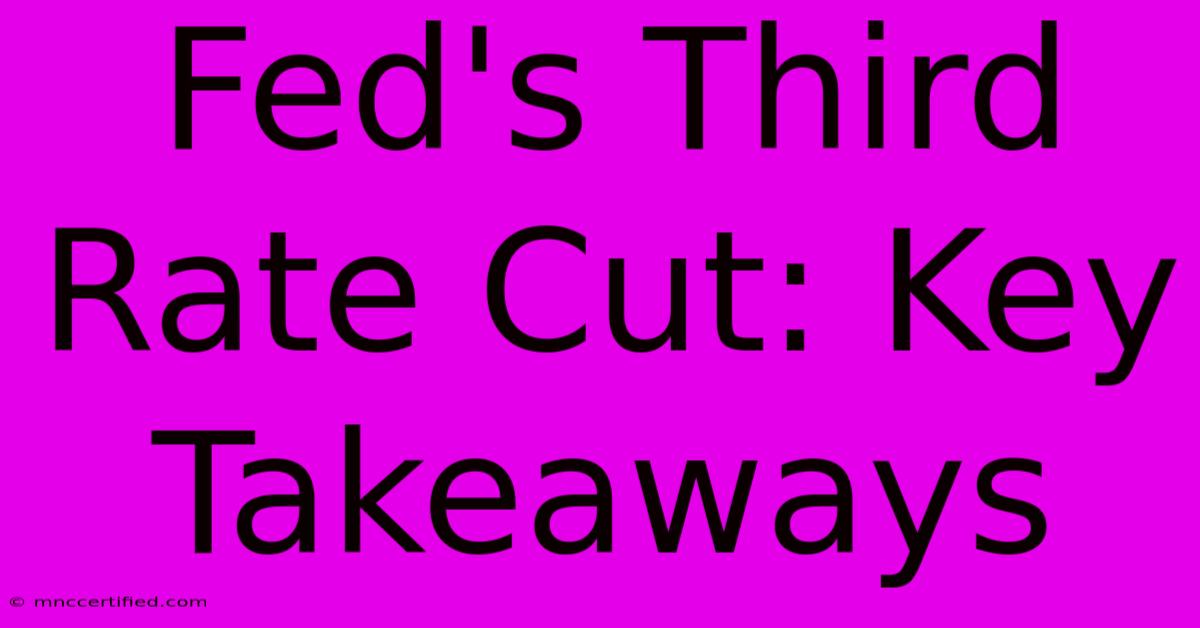Fed's Third Rate Cut: Key Takeaways

Table of Contents
Fed's Third Rate Cut: Key Takeaways and What it Means for You
The Federal Reserve's recent decision to cut interest rates for the third time this year sent ripples through the financial markets. While intended to stimulate economic growth, the move has sparked debate about its effectiveness and potential consequences. This article breaks down the key takeaways from the Fed's third rate cut, exploring its implications for consumers, businesses, and the overall economy.
Understanding the Rate Cut
The Federal Reserve (often called the Fed) lowered the federal funds rate, a benchmark interest rate that influences borrowing costs across the economy. This third cut, following previous reductions in July and September, aims to counteract slowing economic growth and mitigate the risks posed by global uncertainty. The magnitude of the cut, as well as the accompanying statements from the Fed, are crucial for interpreting its impact. A larger cut generally signals a more urgent concern about the economy's trajectory.
Why Did the Fed Cut Rates Again?
Several factors contributed to the Fed's decision. These include:
- Slowing Economic Growth: Concerns about weakening global growth, trade tensions, and slowing domestic investment played a significant role. Data on manufacturing, business investment, and consumer spending pointed to a less robust economy than anticipated.
- Inflation Concerns: While inflation remains relatively low, the Fed aims to prevent deflation – a sustained decline in prices that can be detrimental to economic activity. A rate cut can help stimulate spending and boost inflation towards the Fed's target.
- Global Uncertainty: Geopolitical risks, including trade wars and Brexit, create uncertainty that can impact investment and economic confidence. The Fed aims to provide a buffer against these external shocks.
Key Takeaways from the Third Rate Cut
This third rate cut is sending a clear message: the Fed is committed to supporting economic growth, even if it means deviating from its traditional approach to monetary policy. Here are the key takeaways:
- Accommodative Monetary Policy: The Fed is pursuing an accommodative monetary policy, meaning it's making borrowing cheaper to encourage investment and spending. Lower interest rates translate to lower borrowing costs for businesses and consumers.
- Emphasis on Data Dependence: The Fed's communication emphasized its data-dependent approach. This indicates future rate adjustments will depend on incoming economic data, suggesting further cuts are possible depending on the economic outlook.
- Limited Effectiveness Debate: The effectiveness of further rate cuts is a point of ongoing debate. Some economists argue that lower rates have diminishing returns, and other fiscal policies may be needed to stimulate significant economic growth.
What Does This Mean for You?
The impact of the rate cut varies depending on your circumstances:
- Borrowers: Lower interest rates generally translate to lower mortgage rates, auto loan rates, and credit card interest rates, making borrowing more affordable.
- Savers: Conversely, lower interest rates mean lower returns on savings accounts and certificates of deposit.
- Businesses: Reduced borrowing costs can encourage businesses to invest in expansion and hiring, potentially leading to job growth.
Looking Ahead: Future Rate Adjustments and Economic Outlook
Predicting the Fed's future moves is challenging, but several factors will likely influence its decisions:
- Economic Data: The Fed will closely monitor indicators like GDP growth, inflation, employment, and consumer spending.
- Global Economic Conditions: Global growth prospects and geopolitical developments will significantly impact the Fed's outlook.
- Market Reactions: The market's response to the rate cuts will also factor into future decisions.
The Fed's third rate cut is a significant development with far-reaching consequences. While it aims to boost economic growth, its effectiveness remains subject to ongoing debate. Staying informed about economic indicators and the Fed's communication is crucial for navigating the evolving economic landscape.
Keywords: Fed rate cut, interest rates, Federal Reserve, monetary policy, economic growth, inflation, recession, borrowing costs, savings rates, economic outlook, data dependence, global uncertainty, fiscal policy
Off-Page SEO Considerations: Promote this article through social media, link building (reaching out to relevant websites and blogs in the finance and economics niche), and engaging with discussions on relevant online forums and communities. Consider submitting the article to relevant online publications or directories.

Thank you for visiting our website wich cover about Fed's Third Rate Cut: Key Takeaways. We hope the information provided has been useful to you. Feel free to contact us if you have any questions or need further assistance. See you next time and dont miss to bookmark.
Featured Posts
-
Understanding The Feds Third Rate Cut
Dec 19, 2024
-
Your Christmas Dilemma Ask Cody Gakpo
Dec 19, 2024
-
Bucks Lillard Gets Adidas Lifetime Deal
Dec 19, 2024
-
Brentford V Newcastle On Tv Time And Channel
Dec 19, 2024
-
825 Million Mega Millions Jackpot
Dec 19, 2024